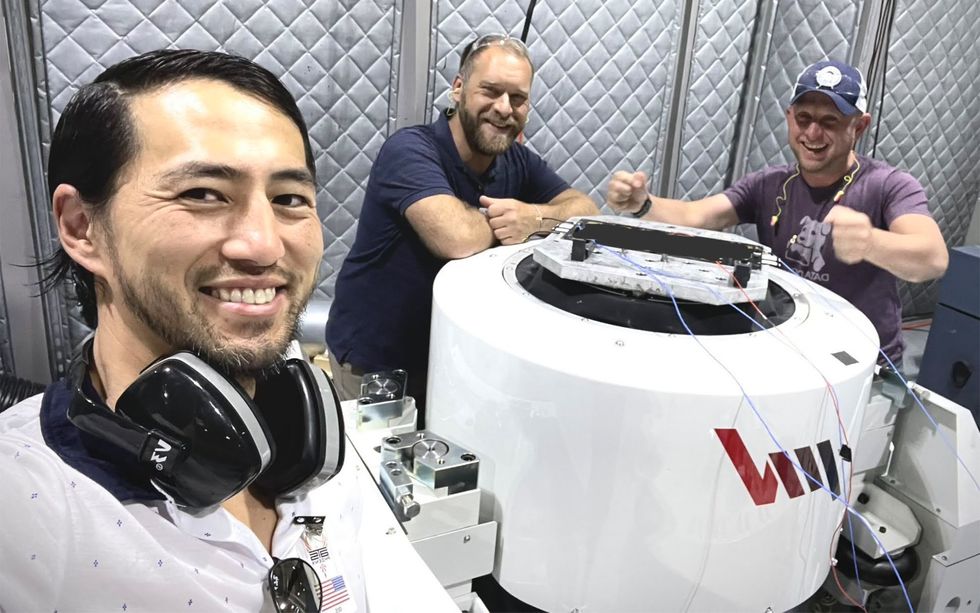Startup Sends Bluetooth Into Low Earth Orbit

A recent Bluetooth connection between a device on Earth and a satellite in orbit signals a potential new space race-this time, for global location-tracking networks.
Seattle-based startup Hubble Network announced today that it had a letter of understanding with San Francisco-based startup Life360 to develop a global, satellite-based Internet of Things (IoT) tracking system. The announcement follows on the heels of a 29 April announcement from Hubble Network that it had established the first Bluetooth connection between a device on Earth and a satellite. The pair of announcements sets the stage for an IoT tracking system that aims to rival Apple's AirTags, Samsung's Galaxy SmartTag2, and the Cube GPS Tracker.
Bluetooth, the wireless technology that connects home speakers and earbuds to phones, typically traverses meters, not hundreds of kilometers (520 km, in the case of Hubble Network's two orbiting satellites). The trick to extending the tech's range, Hubble Network says, lies in the startup's patented, high-sensitivity signal detection system on a LEO satellite.
We believe this is comparable to when GPS was first made available for public use." -Alex Haro, Hubble Network
The caveat, however, is that the connection is device-to-satellite only. The satellite can't ping devices back on Earth to say signal received," for example. This is because location-tracking tags operate on tiny energy budgets-often powered by button-sized batteries and running on a single charge for months or even years at a stretch. Tags are also able to perform only minimal signal processing. That means that tracking devices cannot include the sensitive phased-array antennas and digital beamforming needed to tease out a vanishingly tiny Bluetooth signal racing through the stratosphere.
There is a massive enterprise and industrial market for send only' applications," says Alex Haro, CEO of Hubble Network. Once deployed, these sensors and devices don't need Internet connectivity except to send out their location and telemetry data, such as temperature, humidity, shock, and moisture. Hubble enables sensors and asset trackers to be deployed globally in a very battery- and cost-efficient manner."
Other applications for the company's technologies, Haro says, include asset tracking, environmental monitoring, container and pallet tracking, predictive maintenance, smart agriculture applications, fleet management, smart buildings, and electrical grid monitoring.
To give you a sense of how much better Hubble Network is compared to existing satellite providers like Globalstar," Haro says, We are 50 times cheaper and have 20 times longer battery life. For example, we can build a Tile device that is locatable anywhere in the world without any cellular reception and lasts for years on a single coin cell battery. This will be a game-changer in the AirTag market for consumers."
 Hubble Network chief space officer John Kim (left) and two company engineers perform tests on the company's signal-sensing satellite technology. Hubble Network
Hubble Network chief space officer John Kim (left) and two company engineers perform tests on the company's signal-sensing satellite technology. Hubble Network
The Hubble Network system-and presumably the enhanced Life360 Tags that should follow today's announcement-use a lower energy iteration of the familiar Bluetooth wireless protocol.
Like its more famous cousin, Bluetooth Low-Energy (BLE) uses the 2.4 gigahertz band-a globally unlicensed spectrum band that many Wi-Fi routers, microwave ovens, baby monitors, wireless microphones, and other consumer devices also use.
Haro says BLE offered the most compelling, supposedly short-range" wireless standard for Hubble Network's purposes. By contrast, he says, the long-range, wide-area network LoRaWAN operates on a communications band, 900 megahertz, that some countries and regions regulate differently from others-making a potentially global standard around it that much more difficult to establish and maintain. Plus, he says, 2.4 GHz antennas can be roughly one-third the size of a standard LoRaWAN antenna, which makes a difference when launching material into space, when every gram matters.
Haro says that Hubble Network's technology does require changing the sending device's software in order to communicate with a BLE receiver satellite in orbit. And it doesn't require any hardware modifications of the device, save one-adding a standard BLE antenna. This is the first time that a Bluetooth chip can send data from the ground to a satellite in orbit," Haro says. We require the Hubble software stack loaded onto the chip to make this possible, but no physical modifications are needed. Off-the-shelf BLE chips are now capable of communicating directly with LEO satellites."
We believe this is comparable to when GPS was first made available for public use," Haro adds. It was a groundbreaking moment in technology history that significantly impacted everyday users in ways previously unavailable."
What remains, of course, is the next hardest part: Launching all of the satellites needed to create a globally available tracking network. As to whether other companies or countries will be developing their own competitor technologies, now that Bluetooth has been revealed to have long-range communication capabilities, Haro did not speculate beyond what he envisions for his own company's LEO ambitions.
We currently have our first two satellites in orbit as of 4 March," Haro says. We plan to continue launching more satellites, aiming to have 32 in orbit by early 2026. Our pilot customers are already updating and testing their devices on our network, and we will continue to scale our constellation over the next 3 to 5 years."